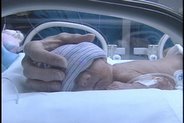Were all three patients colonized by the same strain of MRSA? If so, what was the source and how could patients in three separate rooms become infected with the same pathogen?
Researchers used air sampling machines and surface swabs to collect MRSA samples. Then the samples were analyzed using polymerase chain reaction and pulsed-field gel electrophoresis. The result?
"An epidemiological study demonstrated that clinical isolates of MRSA in our ward were of one origin and that the isolates from the air and from inanimate environments were identical to the MRSA strains that caused infection or colonization in the inpatients."The conclusions of this study indicate that disinfecting the air circulated within their ward could help reduce colonization of patients (bold emphasis added by me).
"In this study, we confirmed that MRSA could be acquired by medical staff and patients through airborne transmission. The findings suggest the importance of protecting patients against cross-infectious agents existing in aerosols. Although measures for prevention and control of nosocomial infection with MRSA include handwashing with an antimicrobial agent; wearing a gown, gloves, and a mask; and removing MRSA from the nasal vestibule, few measures have been established to control airborne bacteria. Laminar unidirectional airflow, air ventilation, and air filtration could also be beneficial in hospital environments and should be considered. Further studies will be needed to assess the levels of MRSA contamination of air and to develop more effective means of controlling and removing airborne MRSA."Once again we see that there is no silver bullet for infection control. Disease transmission is not all contact, nor is it all airborne, rather it is a dynamic combination of many things. In this hospital ward, airborne transmission took on increased importance because the patients in this care unit lack typical host defense mechanisms in their upper respiratory tracts.
VIGILAIR® systems are proven to reduce pathogen load within the air stream by destroying microorganisms with UVGI, and removing the microorganisms with filtration. You may download the research article in its entirety here.
Reference:
Teruo Shiomori, MD, PhD; Hiroshi Miyamoto, MD, PhD; Kazumi Makishima, MD, PhD. Significance of Airborne Transmission of Methicillin-Resistant Staphylococcus aureus in an Otolaryngology–Head and Neck Surgery Unit. Arch Otolaryngol Head Neck Surg. 2001;127:644-648


No comments:
Post a Comment